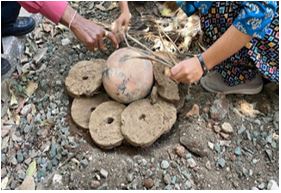Preparation of Visarpahar Taila by Patalyantra Method and Pharmaceutico-Analytical Study of Visarpahar Taila Cream
Keywords:
Ayurveda, Visarpahar Taila, Visarpahar Taila Cream, Visarpa, Skin Diseases, Sneha KalpanaAbstract
Sneha Kalpana is a group of medicated Taila and Ghrita. Sneha Kalpanas manufactured in ayurvedic pharmaceutics are used extensively for medical as well as cosmetic purpose. Taila Kalpanas are the unique formulations of Ayurvedic treatment comes under Sneha Kalpana. Visarpahar Taila is medicated oil used in Ayurveda for Visarpa Vyadhi. Visarpa is correlated with herpes. It is characterized by supportive epithelial inflammatory condition. Skin is the outermost covering of the body serving as a barrier between the external and internal environment. The aggravation of various Dhatus and Doshas results in skin diseases. More than one fifty skin related diseases are described in ayurvedic texts. Visarpa is a common disease mentioned in ayurvedic texts which spreads in body in various directions. Visarpahar Taila has been described in Rasaratna Samucchay to be used in Visarpa Vyadhi. As per modern concept, it is said to be caused by Varicella zoster virus. It manifests Daha (Burning sensation), Jwara (fever), Anunnatshopha (swelling) and Vedana (pain). Visarpahar Tail has been prescribed as it's directly act on skin and its content possesses the properties of Visarpanashak. The aim of the present study is to prepare Visarpahar Taila by Patalyantra method and it's conversion into cream. In present article, we are trying to study analytical results of Visarpahar Taila cream.
Downloads
References
Sharangadhara. Sharangadhara Samhita with commentaries by Brahmanand Tripathi, Madhyama Khand 9, Verse 1. Chaukhambha Surbharati Prakashan, Varanasi. Reprint Edition 2001,Pg218.
Priyavrat Sharma. Dhanvantari Nighantu, Amragandhi Varga. Chaukhambha Orientalia, Varanasi. 3rd edition, 2005, Pg105.
Indradev Tripathi, Acharya Vishwanath Dwivedi. Raj Nighantu Commentory (Hindi) Prabhadradi Varga. Chaukhambha Krishnadas Academy, Varanasi. Reprint edition 2010, Pg264.
Priyavrat Sharma. Dhanvantari Nighantu, Amragandhi Varga. Chaukhambha Orientalia, Varanasi. 3rd edition, 2005,Pg58.
Priyavrat Sharma. Dhanvantari Nighantu, Amragandhi Varga. Chaukhambha Orientalia, Varanasi. 3rd edition, 2005,Pg776.
Tripathi B. Sharangdhar Samhita, Ghrut Taila Kalpana, Madhyam Khanda, chapter 9, Verse 1-2. Varanasi; Chaukhamba Surbharti Prakashan. reprint ed, 2017,Pg144.
Indradev Tripathi, Acharya Vishwanath Dwivedi. Raj Nighantu Commentory (Hindi), Shatavhadi Varga. Chaukhambha Krishnadas Academy, Varanasi. Reprint edition 2010, Pg102.
Indradev Tripathi, Acharya Vishwanath Dwivedi. Raj Nighantu Commentory (Hindi), Dharanyadi Varga. Chaukhambha Krishnadas Academy, Varanasi. Reprint edition 2010, Pg39.
Indradev Tripathi. Rasaratna Samucchay, Visarpakushthashwitra Chikitsa Adhyay. Chaukhambha Academy, Varanasi. 3rd Edition 2006, Shlok 4-5,Pg243.
Sachin S Sheth, Gangaprasad R Asore, Kiran Sudhakar Darade. Pharmaceutico-Analytical study of Karanjadi Taila and its conversion into cream. J Ayurveda Integr Med Sci. 2020;5:245-249.
Indradev Tripathi. Rasaratnasamucchay. Chaukhambha Academy, Varanasi. 3rd Edition 2006, Yantranirupanam Adhyaya, Pg98.
Pandit Kashinatha Shastri. Rasatarangini, Yantravidnyaniya Chaturtha Tarang. Motilal Banarasidas, Varanasi. 8th Edition 2014, Shlok no 47-52,Pg56.
Gaurav Kumar. Text book of cosmetic formulations. May 2018. Page No 57.
Anonymous. Ayurvedic Pharmacopoeia of India, Part 1, volume VII, Appendix 2,3,. Government of India, Ministry of Health and family welfare, Department of AYUSH. 2007, Page No 243, 213, 290, 300, 299, 298, 290, 291, 301.















